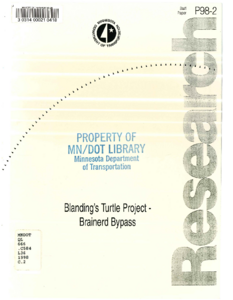Displaying results 1 - 10 of 29
Environmental Hazard Assessment For Transportation Related Chemicals: Development of a Decision Support Tool
Date Created
2004
Report Number
2004-14
Description
Culvert Length and Interior Lighting Impacts to Topeka Shiner Passage
Creator
Date Created
2017
Report Number
2017-44
Description
Performance Assessment of Oversized Culverts to Accommodate Fish Passage
Date Created
2011
Report Number
2011-19
Description
Cost Analysis of Alternative Culvert Installation Practices in Minnesota
Date Created
2009
Report Number
2009-20
Description
The Wildlife Value of Reed Canarygrass Infested Wetlands in Minnesota
Creator
Date Created
2008
Report Number
2008-49
Description
Blanding's Turtle Project - Brainerd Bypass
Date Created
1998-10
Report Number
P98-2
Description
Minnesota Guide for Stream Connectivity and Aquatic Organism Passage Through Culverts
Date Created
2019
Report Number
2019-02
Description










